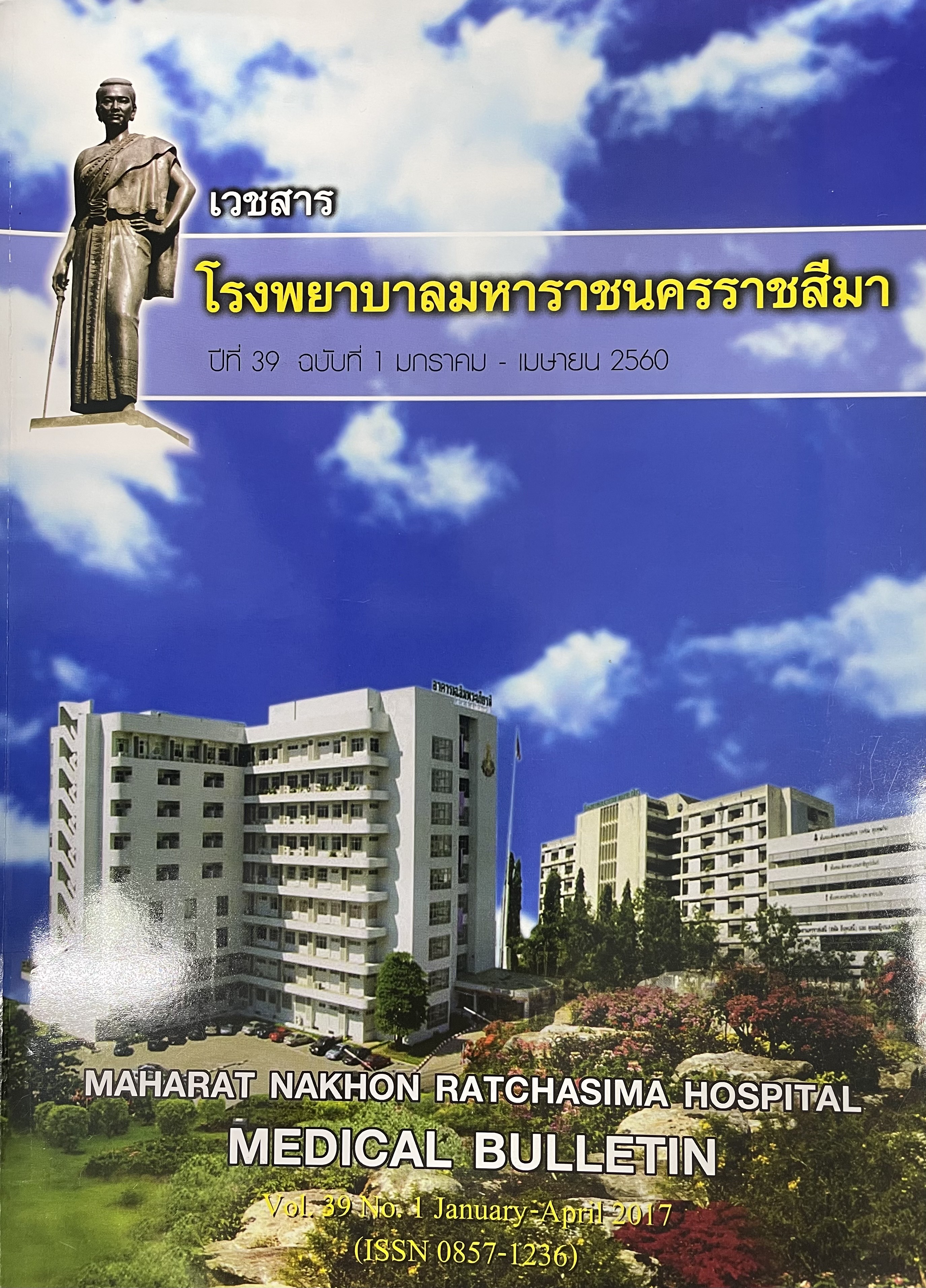ผู้ป่วยโรค ฮีโมโกลบิน เอช และ โลหิตจางจากการขาดธาตุเหล็ก หายซีดหลังจากได้รับการรักษาด้วยเหล็กเพียงพอ: รายงานผู้ป่วย 1 ราย
Main Article Content
บทคัดย่อ
Abstract: โรค Hemoglobin H (Hb H) เป็นโลหิตจางกรรมพันธุ์ ผู้ป่วยโรคนี้มักมีอาการโลหิตจางปานกลาง มีความเข้มข้นของฮีโมโกลบิน เฉลี่ยประมาณ 8.58+1.16 กรัม% หรือ พิสัย ระหว่าง 5.7 ถึง 11.1 กรัม% แต่ในการศึกษานี้เป็นผู้ป่วยโรค Hb H ที่หายจากอาการโลหิตจางได้สนิทหลังจากรักษาภาวะแทรกซ้อนจากการมีโลหิตจางจากการขาดธาตุเหล็ก ผู้ป่วยเป็นชายไทยโสดอายุ 49 ปี มีอาการโลหิตจางและม้ามโตตั้งแต่เป็นเด็กเล็ก ได้รับการวินิจฉัยว่าเป็นโรค Hb H จากการตรวจ Hb electrophoresis ซึ่งภายหลังได้รับการตรวจยืนยัน genotype ว่าเป็น α(0)-thalassemia กับ α(+)-thalassemai ด้วยวิธี polymerase chain reaction ผู้ป่วยมี Hb ระหว่าง 2.6-3.2 กรัม% ต้องได้รับเลือดทุกเดือนตลอดมาจนอายุได้ 29 ปี ผู้ป่วยได้รับการตัดม้ามเพราะสงสัยว่าจะมีภาวะ hypersplenism หลังผ่าตัดผู้ป่วยมี Hb ประมาณ 4.2-5.9 กรัม% ยังคงต้องรับเลือดทุกเดือนเหมือนเคยจนเมื่ออายุ 47 ปี ผู้ป่วยได้รับเลือดไปแล้วประมาณ 500 หน่วย แต่ตรวจพบ serum ferritin ระหว่าง 5.4-7.2 นาโนกรัม/มล, serum iron 38 ไมโครกรัม/ดล., transferrin 258.2 ไมโครกรัม/ดล., transferrin saturation 10.4 %. ส่องตรวจกระเพาะอาหารพบ generalized mild hypertrophic gastritis with multiple erosions ผู้ป่วยได้รับการวินิจฉัยอย่างแน่ชัดว่ามีโรคโลหิตจางจากการขาดธาตุเหล็กซ้ำเติม โรคฮีโมโกลบิน เอช หลังจากรักษาด้วยยาที่เข้าธาตุเหล็กวันละ 3 เม็ด ภายใน 1 เดือน ระดับ Hb ขึ้นถึง 10 กรัม% โดยไม่ต้องเติมเลือด และ Hb ยังคงอยู่ประมาณ 10.4+1.7 กรัม%, Hct 33.8+6.1% ในขณะที่ระดับ ferritin อยู่ที่ 14.7 นาโนกรัม/มล. ผู้ป่วยยังคงได้รับยาเข้าธาตุเหล็กต่อไป หลังจากรักษาได้ 2 ปี Hb ขึ้นเป็น 14.9+3.9 กรัม%, Hct 50.0+1.6%, ferritin 386.1 นาโนกรัม/มล. ตรวจ PCR สำหรับ JAK2 V617F mutation ไม่พบส่วน PCR สำหรับการตรวจยืนยันยีนส์ธาลัสซีเมียนั้น พบ Southeast Asian deletion และ 3.7 kb deletion ผู้ป่วยของเราได้แสดงให้เห็นว่า ถ้าพบผู้ป่วยโรค ฮีโมโกลบิน เอช ที่มีอาการโลหิตจางอย่างรุนแรงควรมีการหาสาเหตุให้ชัดเจน เช่น การขาดธาตุเหล็ก มิฉะนั้นโอกาสที่ผู้ป่วยจะหายจากอาการโลหิตจาง ต้องเนิ่นนานมาเป็นหลายทศวรรษ
Article Details

อนุญาตภายใต้เงื่อนไข Creative Commons Attribution-NonCommercial-NoDerivatives 4.0 International License.
เอกสารอ้างอิง
Sutcharitchan P, Wang W, Settapiboon R, Amornsiriwat S, Tan ASC, Chong SS. Hemoglobin H disease classification by isoelectric focusing: Molecular verification of 110 cases from Thailand. Clin Chem 2005; 51: 641-4.
Waye JS, Eng B, Patterson M, Walker L, Carcao MD, Olivieri NF, et al. Hemoglobin H (Hb H) disease in Canada: molecular diagnosis and review of 116 cases. Am J hematol 2001; 68: 11-5.
Taher A, Vichinsky E, Musallam K, Cappellini MD, Viprakasit V. Guidelines for management of nontransfusion dependent thalassemia (NTDT). In: Thalassemia International Federation, Weatherall D, ed, Nicosia, Cyprus, 2013.
Origa R, Sollaino MC, Giagu N, Barella S, Campus S, Mandas C, et al. Clinical and molecular analysis of haemoglobin H disease in Sardinia: haematological, obstetric and cardiac aspects in patients with different genotypes. Br J Haematol 2007; 136: 326-32.
Fucharoen S, Viprakasit V. Hb H disease: clinical course and disease modifiers. Hematology: Am Soc Hematol Educ Program 2009; 2009: 26-34.
Guyatt GH, Oxman AD, Ali M, Willan A, McIlroy W, Patterson C. Laboratory diagnosis of iron-deficiency anemia: an overview. J Gen Intern Med 1992; 7: 145-53.
Johnson-Wimbley TD. Diagnosis and management of iron deficiency anemia in the 21st century. Therap Adv Gastroenterol 2011; 4: 177-84.
Lal A, Michael L, Goldrich BA, Drucilla A, Haines PNP, Azimi M, et al. Heterogeneity of hemoglobin H disease in childhood. N Engl J Med 2011; 364: 710-8.
Hsu HC, Lin KC, Tsay SH, Tse E, Ho CH, Chow MP, et al. Iron overload in Chinese patients with hemoglobin H disease. Am J Hematol 1990; 34: 287-90.
Tso SC, Loh TT, Todd D. Iron overload in patients with haemoglobin H disease. Scand J Haematol 1984; 32: 391-4.
Chen FE, Ooi C, Ha SY, Cheung BM, Todd D, Liang R, et al. Genetic and clinical features of hemoglobin H disease in Chinese patients. N Engl J Med 2000; 343: 544-50.
Zhu A, Kaneshiro M, Kaunitz JD. Evaluation and treatment of iron deficiency anemia: A gastroenterological perspective. Dig Dis Sci 2010; 55: 548-59. doi: 10.1007/ s10620-009-1108-6.
Annibale B, Capurso G, Chistolini A, D’Ambra G, DiGiulio E, Monarca B, et al. Gastrointestinal causes of refractory iron deficiency anemia in patients without gastrointestinal symptoms. Am J Med 2001; 111: 439-45.
Barbui T, Thiele J, Vannucchi AM, Tefferi A. Rationale for revision and proposed changes of the WHO diagnostic criteria for polycythemia vera, essential thrombocythemia and primary myelofibrosis. Blood Cancer J 2015; 5(8): e337. doi: 10.1038/bcj. 2015.64.
Mason PJ, Bautista JM, Gilsanz F. G6PD deficiency: the genotype-phenotype association. Blood Rev 2007; 21: 267-83.
Chao YH, Wu KH, Wu HP, Liu SC, Peng CT, Lee MS. Clinical features and molecular analysis of Hb H disease in Taiwan. Biomed Res Int 2014; 2014: 271070. Doi: 10.1155/2014/271070.
Kassim A, Thabet S, Al-Kabban M, Al-Nihari K. Iron deficiency in Yemeni patients with sickle-cell disease East Mediterr Health 2012; 18: 241-5.
Medinger M, Saller E, Harteveld CL, Lehmann T, Graf L, Rovo A, et al. A rare case of coinheritance of Hemoglobin H disease and sickle cell trait combined with severe iron deficiency. Hematol Rep 2011; 3:e30. doi: 10.4081/hr.2011.e30.
Origa R, Cazzola M, Mereu E, Danjou F, Barella S, Giagu N, et al. Differences in the erythropoiesishepcidin-iron store axis between hemoglobin H disease and β-thalassemia intermedia. Haematologica 2015; 100(5): e169-e171.doi:10.3324/ haematol.2014.115733.
Jaeger M, Aul C, Söhngen D, Germing U, Schneider W. Secondary hemochromatosis in polytransfused patients with myelodysplastic syndromes. Beitr Infusionsther 1992; 30: 464-8. (English abstract)
Ragusa R, Di Cataldo A, Gangarossa S, Lo Nigro L, Schilirò G. Low-grade haemolysis and assessment of iron status during the steady state in G6PD-deficient subjects. Acta Haematol 1993; 90: 25-8.


